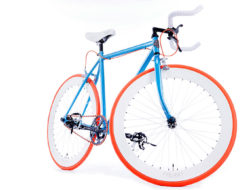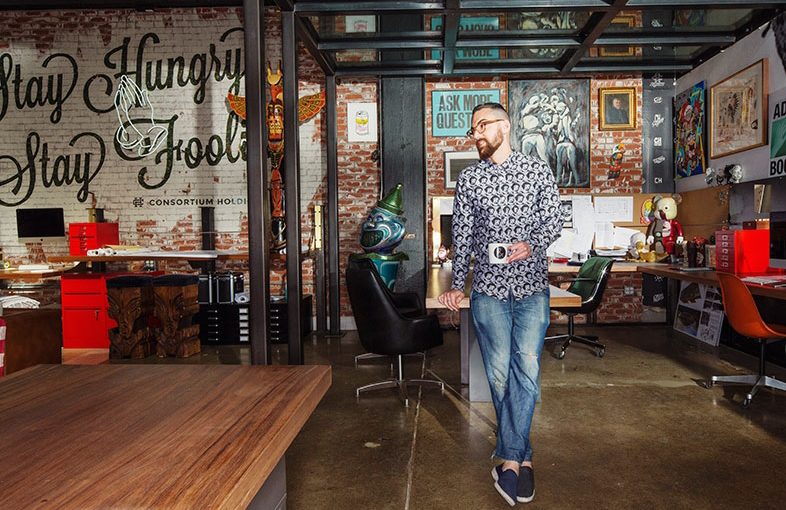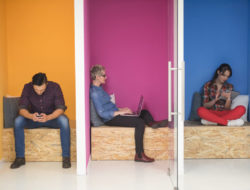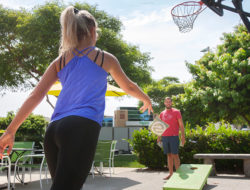Arsalun Tafazoli is arguably the most controversial restaurateur in San Diego. Over the past decade, he’s opened 16 eateries and bars that have won critical acclaim and a James Beard nod for their bold architecture and strong cocktails, as well as scorn for the unwavering no-ketchup and no-vodka policies. As his firm, CH Projects, and local architect Paul Basile prepare to open a revamped Craft & Commerce, Tafazoli shares his thoughts on design and we look inside where he works.
Why is a restaurant’s design so important to the experience of dining out?
We believe environment dictates behavior, and design dictates environment. The best food on the planet shared with an asshole is a shitty meal, and shitty food with a great companion is still a good experience. So we try to design our spaces to encourage human interaction and good conversation.

When Tafazoli wanted a mural of a scene in American Psycho in the office, Basile placed the image on the wall first and worked the height of the suspended conference room around it.
What was San Diego’s restaurant scene missing before you founded your company?
There wasn’t much of a dining and social culture in SD, or “Bland Diego,” as we used to pretentiously joke about it. I think our city was viewed as more transient, and most restaurant owners catered more to tourists than locals. Being a progressive restaurant or bar meant you had more flat-screen televisions or an all-you-can-eat salad bar. We wanted to create spaces that became a part of the fabric of the communities they were in, and create long-term relationships with our guests. We hoped that creating well-designed, timeless environments would help them evolve into community institutions.
Which of your establishments took the most time to develop?
I think UnderBelly, our interpretation of a ramen-ya [ramen restaurant]. The whole project was about paying tribute to a culture we love and respect but are never really a part of, so we were on the outside looking in. Whereas there is something really American about an oyster bar or burger concept, which obviously makes that development a little more fluid for us.

Basile says he and Tafazoli share an addiction to eBay, and the resulting odds and ends, like this totem pole and chair, are found throughout the building. “The shelves were purposely designed to house the leftover decor items that we had purchased but didn’t end up using in the 12 locations that we’ve worked on together,” he adds.
How has your style changed since you first started in 2007?
I think when we were younger, we had more of a chip on our shoulder with more to prove, and we wanted to rock the proverbial design boat. That fire doesn’t burn as hot anymore. Not everything has to be about going against the grain; we just want to do good projects that are filling a cultural void in a city we love. It’s less about making a statement and more about enjoying the process.
Is there anything in your restaurants that you look at now and say, “Why did I do that?”
There are always unintended consequences that we miss in development that come to surface when people start filling the space. On the UnderBelly patio deck, we took a piece of cold roll steel and water-jetted “F**K HYPE,” then filled it in with resin and had it backlit with LEDs. This was a project we did about six years ago, and we were younger, angrier. Looking back, it was a little much, vulgar and unnecessary, but that’s what youth is for—I think.

CH employees meet in front of the test cocktail bar and work at wall-mounted desks and stations.
What are you tired of seeing in restaurants today?
Exposed filament bulbs and reclaimed wood paneling.
You won so many awards for the design of Craft & Commerce. Why change it now?
I think it was Woody Allen in Annie Hall who said a relationship is like a shark; if it’s not moving forward, it’s dying. That’s kind of how we feel about our projects. We have learned a lot since we first designed and built Craft & Commerce—and frankly, we didn’t have the budget or resources we have now. The DNA of the design is staying the same and it’s going to feel very familiar to the original.
People have strong opinions about your restaurants: They either fawn over them or send you hate mail. How does that make you feel?
We have always strived to be a catalyst for analytical thought and get people outside of their comfort zone. We want to make an emotional connection and force people to form an opinion. Either love us or hate us, but don’t be indifferent. The places that try to be all things to all people never end up doing anything all that well. While challenging the status quo and mass consensus have never been the most profitable ethos, we are fortunate that we don’t need to win over every person to be successful.
Send us your office space… mariet@sandiegomagazine.com
Tags: Consortium Holdings, Office Space, Offices






























